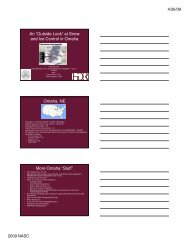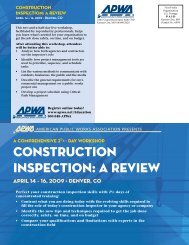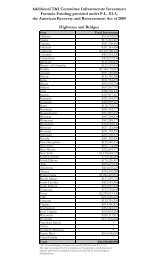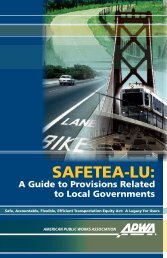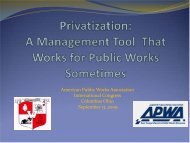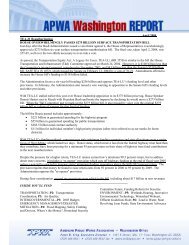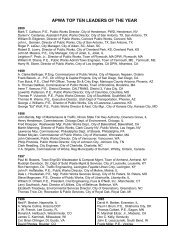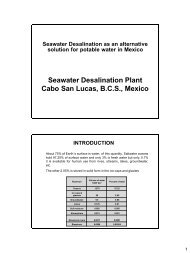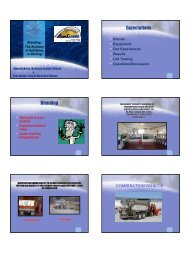Anti-icing & De-icing using a 30:70 ratio of liquid/dry material Topics ...
Anti-icing & De-icing using a 30:70 ratio of liquid/dry material Topics ...
Anti-icing & De-icing using a 30:70 ratio of liquid/dry material Topics ...
- No tags were found...
Create successful ePaper yourself
Turn your PDF publications into a flip-book with our unique Google optimized e-Paper software.
<strong>Anti</strong>-<strong>icing</strong> & <strong>De</strong>-<strong>icing</strong> <strong>using</strong> a <strong>30</strong>:<strong>70</strong> <strong>ratio</strong> <strong>of</strong> <strong>liquid</strong>/<strong>dry</strong> <strong>material</strong>Presentation for APWA Snow conference, Peoria IllinoisMay 2, 2006Lucas Hooijenga - Schmidt North America<strong>Topics</strong> to be discussedContent• <strong>De</strong>-<strong>icing</strong> and anti-<strong>icing</strong> practices typically used by U.S. organizations• History <strong>of</strong> de-<strong>icing</strong> and anti-<strong>icing</strong> in Europe• Pre-wet at a <strong>30</strong>:<strong>70</strong> <strong>ratio</strong>• What is different about the spreader?• Experience from users:•Maine DOT• New Jersey DOT (report)•SummaryName: YYYY-MM-DD Documenttitle 2History <strong>of</strong> de-<strong>icing</strong> and anti-<strong>icing</strong> in EuropeWinter Maintenance TechniquesHistory <strong>of</strong> spreading in Europe:• 50’s: man with shovel – introduction <strong>of</strong> salt• 60’s: introduction <strong>of</strong> (salt) spreader• <strong>70</strong>’s: ground speed relation• 80’s: pre-wetting• 90’s: environment becomes a“hot” issue• 00’s: data loggingPre-wet at a <strong>30</strong>:<strong>70</strong> <strong>ratio</strong>Step 1: Pre-wet at a 3-5% <strong>ratio</strong>• Initial start with pre-wet:• pre-treatment <strong>of</strong> stock pile• treatment <strong>of</strong> salt in the hopper• Why are we <strong>using</strong> only 3 - 5 %?• maximum amount that salt can contain• General experience:• better melting performance – “kick start” effect• small particles also adhere to the road• result is <strong>using</strong> less saltName: YYYY-MM-DD Documenttitle 3Name: YYYY-MM-DD Documenttitle 4Pre-wet at a <strong>30</strong>:<strong>70</strong> <strong>ratio</strong>Step 2: Pre-wet at a 3 - 5% <strong>ratio</strong> – saddle tanksNext step:• mix when the salt is spread• still <strong>using</strong> 5%•How:• Saddle tanks and pump on spreader• Findings: cleaner and easier to operatePre-wet at a <strong>30</strong>:<strong>70</strong> <strong>ratio</strong>Step 3: Pre-wet at <strong>30</strong> - <strong>70</strong> <strong>ratio</strong>• In Europe the next step was a <strong>30</strong> / <strong>70</strong> mixture• Why?• bigger tanks and pumps• integrated design and controls• advanced spreading technologyComments:• why not more <strong>liquid</strong>?• related to speed <strong>of</strong> belt motor and door settings?Name: YYYY-MM-DD Documenttitle 5Name: YYYY-MM-DD Documenttitle 6
Name: YYYY-MM-DD Documenttitle 7Pre-wet at a <strong>30</strong>:<strong>70</strong> <strong>ratio</strong>Step 3: Pre-wet at <strong>30</strong> - <strong>70</strong> <strong>ratio</strong>• Advantages:• mixture is easier to spread, less influence from side wind• mixture will not bounce <strong>of</strong>f the road as quickly and easily• mixture will stick much better to the road• mixture speeds up the process with de-<strong>icing</strong> (kick start effect)• <strong>30</strong>% <strong>liquid</strong>:• when possible – brine can be cheaper• when necessary: CaCl2 in16% or 32% concent<strong>ratio</strong>nPre-wet at a <strong>30</strong>:<strong>70</strong> <strong>ratio</strong>Winter Maintenance ope<strong>ratio</strong>nA typical example <strong>of</strong> <strong>dry</strong> versus pre-wet::Name: YYYY-MM-DD Documenttitle 8Pre-wet at a <strong>30</strong>:<strong>70</strong> <strong>ratio</strong>Is it something new?Stages in de-<strong>icing</strong> and anti-<strong>icing</strong>Do we need two methods?• In Europe:• started early 80’s• common practice now for DOT’s and main roads• last group, currently converting: small fleets (< 5 units)• In North America – 2 test units in winter 2004 – 2005:•Maine DOT:• saved <strong>30</strong>% in salt (conservative – “only scratched the surface”)• have bought 4 units•NJ DOT:• put 55 – 75% less $ (in salt) on the road• have bought 3 combination unitsStage1234<strong>De</strong>-<strong>icing</strong><strong>Anti</strong>-<strong>icing</strong>Dry saltUnknownPre-wet 5%Liquid onlyPre-wet <strong>30</strong>%?Pre-wet <strong>30</strong>%Name: YYYY-MM-DD Documenttitle 9Name: YYYY-MM-DD Documenttitle 10Pre-wet at a <strong>30</strong>:<strong>70</strong> <strong>ratio</strong>Advantages <strong>of</strong> de-<strong>icing</strong> and anti-<strong>icing</strong> with the <strong>30</strong>:<strong>70</strong> <strong>ratio</strong>• Advantages <strong>of</strong> de-<strong>icing</strong> and anti-<strong>icing</strong> with <strong>30</strong>:<strong>70</strong> <strong>ratio</strong>:• Only one unit is needed• No swapping necessary• Easier to operate (driver training)• Same route for anti-<strong>icing</strong> and de-<strong>icing</strong>• Quick change possible from anti-<strong>icing</strong> to de-<strong>icing</strong> (and plowing)The spreader itselfNew methods require new technical solutionsMain difference between European and American spreaders:• Integrated solution: one stop shopping• Spreading discs: better mixing• Controls: very user friendlyAll aimed to put the salt where you want it: the right amount in the right placeName: YYYY-MM-DD Documenttitle 11Name: YYYY-MM-DD Documenttitle 12
Name: YYYY-MM-DD Documenttitle 13The spreader itselfAn integrated design and solutionAdvantages:• Components are designed to work together• No hidden costs in mounting and assembly• One party responsible for the whole spreaderThe spreader itselfSpreading discCompletely made <strong>of</strong> stainless steelHorizontal adjustmentGas spring to raise the chute easilyVertical adjustmentTeflon layerIntermediate bearing betweenspinner motor and spreadingdiscSensor for feedback <strong>of</strong> rotating speed <strong>of</strong> spinner to CPUName: YYYY-MM-DD Documenttitle 14The spreader itselfMixing cone for a optimum mixing <strong>of</strong> salt and brine1. Two chutes to transport salt and brineseparately (no blockage)2. Salt and brine are injected under differentangles – first mixing stage3. Optimized mixing cone – axial mixing4. Radial mixing between cone and flights5. Further radial mixing on the flightsresulting in thoroughly mixed substance,leaving the disc over a broad sectorThe spreader itselfControlsPut the salt where you want it: the right amount in the right placeName: YYYY-MM-DD Documenttitle 15Name: YYYY-MM-DD Documenttitle 16SummarySummary.. Thanks for your attention!• Pre-wet at <strong>30</strong>:<strong>70</strong> <strong>ratio</strong>:• Common practice in Europe• Used for anti-<strong>icing</strong> and de-<strong>icing</strong>• Good experiences in North AmericaName: YYYY-MM-DD Documenttitle 17Name: YYYY-MM-DD Documenttitle 18
.Child Street16 State House StationAugusta, Maine 04333Maine <strong>De</strong>partment <strong>of</strong>TransportationTransportation ResearchDivision. . . . . . . . . .Evaluation <strong>of</strong> the Schmidt-STRATOS SpreaderJuly, 2005
Transportation Research DivisionEvaluation <strong>of</strong> the Schmidt-STRATOS SpreaderIntroductionIn the fall <strong>of</strong> 2004, the Maine <strong>De</strong>partment <strong>of</strong> Transportation (MAINEDOT) entered into an arrangementwith Schmidt International <strong>of</strong> St.Blasien, Germany to evaluate Schmidt’s STRATOS <strong>material</strong> spreader.The MAINEDOT agreed to evaluate the equipment for one winter season and in turn provide informationand feedback to Schmidt International relative to the <strong>De</strong>partment’s experience with the STRATOSspreader.ScopeThe scope <strong>of</strong> this evaluation included a focus on several features <strong>of</strong> the STRATOS, as well as determiningif the recommended seventy percent granular/thirty percent <strong>liquid</strong> combination was a viable option fortypical storm conditions encountered within the State <strong>of</strong> Maine. Also <strong>of</strong> interest to the manufacturer wasthe ease <strong>of</strong> installation, ease <strong>of</strong> ope<strong>ratio</strong>n and general opinions as to the quality <strong>of</strong> their product.MethodologyThe methodology <strong>of</strong> this evaluation included a relatively straight forward approach; simply subject theSTRATOS spreader to “real world” winter storm conditions experienced by the MAINEDOT anddocument the results.AnalysisUtilizing <strong>material</strong> usage information developed by an inventory tracking system, comparisons were madein an effort to determine if <strong>material</strong> savings were present while <strong>using</strong> the STRATOS spreader.Unfortunately, the precision <strong>of</strong> the data collected for inventory purposes is not accurate enough to makean absolute comparison with the standard spreader typically operated by the MAINEDOT. Comparisonswere made nonetheless <strong>using</strong> the available information.About the STRATOS SpreaderOne <strong>of</strong> the potential advantages to <strong>using</strong> the STRATOS spreader is the ability to pre-treat the granular saltwith a significantly higher amount <strong>of</strong> <strong>liquid</strong> <strong>material</strong>. MAINEDOT’s conventional spreaders are limited toa maximum rate <strong>of</strong> 10 gallons <strong>of</strong> <strong>liquid</strong> <strong>material</strong> per ton <strong>of</strong> granular <strong>material</strong>. The STRATOS machine iscapable <strong>of</strong> applying approximately 55 to 60 gallons per ton <strong>of</strong> granular <strong>material</strong>. This additional <strong>liquid</strong>,coupled with the granular salt, creates an end product that has the consistency <strong>of</strong> slurry. This slurryappears to stay in the travel lane much better than the granular salt treated with minimal <strong>liquid</strong>.It is important to note that the MAINEDOT is currently <strong>using</strong> a salt with large particle size. To bestachieve the desired slurry consistency, the <strong>De</strong>partment should continue to pursue the possibility <strong>of</strong>procuring a much finer salt for use with the STRATOS equipment.1
One issue raised by both the operator and supervisor was with the STRATOS equipment recording<strong>material</strong> usage and distance in Metric units. This was discussed with the manufacturer and all future unitswill record <strong>using</strong> the Imperial system <strong>of</strong> measurement.The STRATOS spreader uses a different strategy with respect to application rates than the spreaders andcontrollers currently being used by the <strong>De</strong>partment. This difference immediately produced a <strong>material</strong>savings <strong>of</strong> nearly 25 percent even though the operator and his supervisor were initially unaware thisdifference existed. When requesting an application rate with existing equipment, operators dial-in the rate<strong>of</strong> granular <strong>material</strong> required and the <strong>liquid</strong> is applied at a rate <strong>of</strong> up to 10 gallons per ton automatically.For example, a requested rate <strong>of</strong> 400 pounds per lane mile with conventional units consists <strong>of</strong> 400 pounds<strong>of</strong> granular salt and two gallons <strong>of</strong> brine or 4.6 pounds <strong>of</strong> salt. A 400 pound application request <strong>using</strong> theSTRATOS spreader consists <strong>of</strong> 280 pounds <strong>of</strong> granular salt and 120 pounds <strong>of</strong> salt brine. At anapproximate weight <strong>of</strong> 10.5 pounds per gallon, this equates to about 11.5 gallons <strong>of</strong> brine which isapproximately 26.2 pounds <strong>of</strong> salt.This difference is best explained in Table I below.Conventional SpreaderTABLE I400 Pounds per Lane Mile ApplicationPounds <strong>of</strong> Granular Salt Applied 400Gallons <strong>of</strong> Salt Brine AppliedAt 10 Gallons/Ton <strong>of</strong> Granular Salt 2* Pounds <strong>of</strong> Salt Applied as Salt Brine 4.6Total Pounds <strong>of</strong> Salt Applied Per Lane Mile 404.6Schmidt-STRATOS SpreaderPounds <strong>of</strong> Granular Salt Applied 280Gallons <strong>of</strong> Salt Brine AppliedAt <strong>30</strong> Percent <strong>of</strong> Total Application Rate 11.4* Pounds <strong>of</strong> Salt Applied as Salt Brine 26.2Total Pounds <strong>of</strong> Salt Applied Per Lane Mile <strong>30</strong>6.2Savings per Lane Mile98.4 Pounds* Calculation Based On a 23 Percent Salt Brine Solution(Approximately 2.3 Pounds <strong>of</strong> Salt per Gallon)Even with this 25 percent savings <strong>of</strong> <strong>material</strong>, the operator and his supervisor reported superior meltingand better traveling conditions in the STRATOS treated lane compared to lanes treated with conventionalspreaders.2
InstallationInstallation <strong>of</strong> the STRATOS spreader was completed at the <strong>De</strong>partment’s Fleet Services facility inBangor. This installation took approximately 6 to 8 hours to complete. Fleet Services personnel involvedwith the installation indicated there is “much less wiring” and “fewer hydraulic connections” than wheninstalling the conventional systems. The hydraulic system is self–contained on the spreader and requiresonly two hydraulic fittings. Conventional systems require a minimum <strong>of</strong> three fittings. The only issue toarise during the installation was with the incompatibility <strong>of</strong> the speed sensor sending unit on the vehicleand the STRATOS receiving unit. This condition is related to the age <strong>of</strong> the vehicle and should not be anissue with future installations on newer trucks.It is also interesting to note that at no time was the hydraulic system overtaxed by the amount <strong>of</strong> <strong>material</strong>requested or the corresponding travel speed <strong>of</strong> the truck. With many installations <strong>of</strong> experimentalequipment over the past several years, the <strong>De</strong>partment has experienced instances where the existinghydraulic systems on the vehicles were not capable <strong>of</strong> providing adequate hydraulic flow or pressure tooperate the equipment.Numerous times throughout the installation, MAINEDOT personnel commented on the overall qualityand simplicity <strong>of</strong> the STRATOS spreader.Equipment Features <strong>of</strong> the STRATOS SpreaderSpinner AssemblyPhoto 1 Photo 2A spinner or disc located at the back and center <strong>of</strong> the hopper (photo 1) spreads the <strong>material</strong> in a “ribbon–like” pattern. This pattern can be increased to treat two lanes when desired. The disc can also bepositioned to treat closer to the centerline when necessary, minimizing the loss <strong>of</strong> <strong>material</strong> to the shoulder<strong>of</strong> the roadway. Each <strong>of</strong> these features is adjusted <strong>using</strong> a simple, easy to use controller (photo 2) locatedin the cab <strong>of</strong> the vehicle.3
Belt AssemblyPhoto 3 Photo 4The belt assembly <strong>of</strong> the STRATOS is considered superior to the chain <strong>material</strong> delivery systemscurrently in use on the <strong>De</strong>partment’s conventional hopper spreaders. The belt provides an even,continuous application <strong>of</strong> salt, whereas the chain system <strong>of</strong>ten produces an uneven, skipping application.Photo 3 shows a top-down view <strong>of</strong> the belt, while photo 4 shows the belt from below the hopper. Note theV-shapes used to carry <strong>material</strong>. Another advantage to the belt system is that very little salt is depositedin the body <strong>of</strong> the truck. This is in sharp contrast to what is typically found. The operator indicated that itwas not uncommon to have as much as ½ cubic yard <strong>of</strong> salt in the body <strong>of</strong> the truck when removing hisconventional hopper. With the STRATOS, he typically found less than one small shovel full remaining inthe body.Load Cover and Grate AssemblyPhoto 5 Photo 6Photo 5 shows the load cover in the closed position. It is easily opened and closed by the operator whilestanding on the ground by simply pulling a tethered strap attached to one <strong>of</strong> the cover arms. One minorflaw with the latch holding the cover in the down position did cause the cover to open when traveling at4
highway speeds. This will be corrected on all future units by increasing the latch size. The grate systemused to keep large pieces <strong>of</strong> salt from entering the hopper is pictured in photo 6 with the cover in the openposition.Mounting, <strong>De</strong>-mounting and Storage AssemblyPhoto 7 Photo 8Another positive feature <strong>of</strong> the STRATOS system is the built-in mounting, de-mounting and storageassembly. Legs positioned at each corner <strong>of</strong> the unit fold into position when unloading (photo 7). Thespinner is raised and locked into position when loading, unloading and storing. This unloading andsubsequent loading takes approximately 10 minutes to complete. The storage capability <strong>of</strong> this assembly(photo 8) is considered an excellent alternative to the <strong>De</strong>partment’s aging gantry systems. Note the bluecolored tanks (500 gallon total capacity) mounted at each side <strong>of</strong> the hopper.Electronic Equipment Cover AssemblyPhoto 9 Photo 10The electronic workings <strong>of</strong> the unit are housed in a small hooded compartment located at the rear <strong>of</strong> thehopper (photo 9). MAINEDOT personnel were particularly impressed with the simplistic nature <strong>of</strong> theelectronic operating system and the cleanliness maintained under the hood <strong>of</strong> the compartment even afterbeing exposed to numerous winter storm events (photo 10)5
One mechanical issue occurred during the evaluation period. In early March, a motor used to position thespinner failed. Upon replacement, Fleet Services personnel removed the ho<strong>using</strong> <strong>of</strong> the old motor anddetermined that a screw that holds the ho<strong>using</strong> in place had pierced the seal. This allowed salt and waterto seep into the moving parts <strong>of</strong> the motor ca<strong>using</strong> it to fail. The replacement motor was received withintwo working days and the support provided by the STRATOS manufacturer was very good.Cost <strong>of</strong> Equipment Comparison – STRATOS vs. Conventional SpreaderTo further compare the STRATOS with the <strong>De</strong>partment’s conventional spreaders, an equipment costcomparison was completed. An estimate developed by the <strong>of</strong>fice <strong>of</strong> Fleet Services calculated the total cost<strong>of</strong> the <strong>De</strong>partments conventional hopper/spreader to be $26,800.00. The cost quotation received from theSTRATOS manufacturer was $32,238.00. This calculates to an additional cost <strong>of</strong> $5,438.00 for theSTRATOS equipment. Using the estimated cost <strong>of</strong> <strong>material</strong> saved ($2208.00/year) found in theSTRATOS Spreader Summary in Appendix A, the additional cost <strong>of</strong> the STRATOS would be amortizedin 2.46 years <strong>of</strong> ope<strong>ratio</strong>n.To further calculate replacement costs, Fleet Services also provided a trade-in estimate for anyconventional units already in service within the <strong>De</strong>partment. This estimate was between $3,500.00 and$4,000.00 dollars per unit.A detailed summary <strong>of</strong> this estimate can be found in appendix B.Conclusions/RecommendationsMany MAINEDOT personnel were impressed with the quality and engineering <strong>of</strong> the STRATOS unit.As discussed above, features <strong>of</strong> the STRATOS fit well with the <strong>De</strong>partment’s continued effort to providethe best available equipment to its operators. It is also the goal <strong>of</strong> the <strong>De</strong>partment to continue to strive for<strong>material</strong> savings wherever possible. Based on the results from one winter season, the 25 percent <strong>material</strong>savings described in Table I are considered to be a modest projection. As operators and supervisorsbecome more comfortable with the equipment, additional savings may be realized.The <strong>70</strong> percent granular, <strong>30</strong> percent salt brine <strong>liquid</strong> application worked well in a variety <strong>of</strong> conditionsand temperatures. This high concent<strong>ratio</strong>n <strong>of</strong> <strong>liquid</strong> mixture did not cause “re-freezing” <strong>of</strong> the roadway.Liquid Calcium Chloride was substituted for the brine during one cold temperature (less than 8 degreesFahrenheit) event and worked very well in melting packed snow and ice on several interstate ramps.Overall, the evaluation <strong>of</strong> the STRATOS spreader was considered positive. It is important to note thatthese results are based on a one year evaluation period. This limited time may or may not berepresentative <strong>of</strong> long term performance characteristics <strong>of</strong> the STRATOS equipment.It is recommended that additional evaluations be undertaken to determine the accuracy <strong>of</strong> the meteringequipment, if multiple-lane treatment is a viable option and if anti-<strong>icing</strong> techniques can be conducted<strong>using</strong> the STRATOS. It is also recommended that the <strong>De</strong>partment continue its efforts to provide a finerparticle size salt for use with the STRATOS unit.7
For any future purchases, the <strong>De</strong>partment should require the STRATOS equipment record <strong>material</strong> usageand distance, <strong>using</strong> the Imperial system <strong>of</strong> measurement.Prepared by:Stephen ColsonSenior TechnicianMaterial Testing and Explo<strong>ratio</strong>nReviewed By:Dale PeabodyDivision EngineerTransportation Research DivisionFor more information contact:Stephen ColsonMaine <strong>De</strong>partment <strong>of</strong> TransportationP.O. Box 1208Bangor, Maine 04402 - 1208207-941-4529E-mail: stephen.colson@maine.gov8
Appendix A9
Annual Salt Usage by RouteRoute Route Total Tons Average Tons Per EventNumber <strong>De</strong>scription 2003-2004 2004-2005 2003-2004 2004-20051 Rte. 2 Veazie 42.7 87.3 2.03 2.912 Rte. 16 Alton 122.4 180.6 5.83 6.023 Rte. 1A Holden 124.6 142.5 5.93 4.754 Rte. 15 Kenduskeag 163 229.1 7.76 7.645 Rte. 15 Orrington 115.7 139.8 5.51 4.666I-95 SB/I-395 Right(STRATOS) 140.4 141.2 6.69 4.717 I-95 SB/I-395 Left 121.7 180.7 5.80 6.028 I-95 NB Right 151.1 225 7.20 7.509 I-95 NB Left 174.6 250.7 8.31 8.362003-2004 2004-2005Number <strong>of</strong> Events: 21 <strong>30</strong>Salt Usage Per Season2003-2004 2004-2005Tons/Season<strong>30</strong>02502001501005001 2 3 4 5 6 7 8 9Route NumberAverage Tons Per Event2003-2004 2004-2005Tons/Event10.008.006.004.002.000.001 2 3 4 5 6 7 8 9Route Number10
Schmidt Stratos Spreader SummaryDateEventPounds <strong>of</strong>GranularSaltGallons<strong>of</strong>SaltBrinePounds <strong>of</strong>Salt Total Pounds Total Pounds<strong>of</strong> Salt<strong>of</strong> SaltFrom Brine (actual) (Requested)TotalMilesTreatedAveragePoundsPer Mile(actual)Average PoundsPer Mile(Requested)1/3/2005 9 8472.0 345.8 795.3 9267.3 12180.0 40.6 228.0 299.71/6/2005 10 8656.2 353.3 812.6 9468.8 12180.0 40.6 233.0 299.71/8/2005 11 13696.0 559.0 1285.7 14981.7 18450.0 51.2 292.3 360.01/10/2005 12 9945.5 405.9 933.7 10879.1 14210.0 40.6 267.7 349.61/12/2005 13 10188.2 415.8 956.4 11144.6 14120.0 45.5 245.0 310.41/14/2005 14 4236.1 172.9 397.7 4633.8 6090.0 20.3 228.3 <strong>30</strong>0.01/17/2005 15 4236.1 172.9 397.7 4633.8 6090.0 20.3 228.3 <strong>30</strong>0.01/19/2005 16 9945.5 405.9 933.7 10879.1 14210.0 40.6 267.7 349.61/23/2005 17 10522.8 429.5 987.9 11510.7 157<strong>30</strong>.0 47.7 241.5 3<strong>30</strong>.01/25/2005 18 8072.7 329.5 757.8 88<strong>30</strong>.5 11352.0 35.4 249.3 320.41/26/2005 19 18152.0 740.9 1<strong>70</strong>4.1 19856.0 232<strong>30</strong>.0 71.1 279.3 326.72/4/2005 20 6075.3 248.0 5<strong>70</strong>.3 6645.6 8660.0 24.4 272.8 355.52/10/2005 21 35082.7 1431.9 3293.5 38376.2 60900.0 142.0 2<strong>70</strong>.2 428.82/15/2005 22 4107.2 167.6 385.6 4492.8 6090.0 22.1 203.6 276.02/17/2005 23 8711.8 355.6 817.8 9529.6 12540.0 48.5 196.6 258.72/18/2005 24 5658.0 2<strong>30</strong>.9 531.2 6189.1 7465.0 26.5 233.8 282.02/21/2005 25 22641.1 924.1 2125.5 24766.6 <strong>30</strong>450.0 96.8 255.9 314.73/1/2005 26 13365.7 545.5 1254.7 14620.4 21040.0 54.3 269.2 387.33/7/2005 27 17914.8 731.2 1681.8 19596.6 25520.0 56.2 348.4 453.73/11/2005 28 <strong>70</strong>54.7 287.9 662.3 7717.0 18190.0 45.6 169.4 399.33/14/2005 29 13641.3 556.8 1280.6 14921.9 21621.0 57.7 258.4 374.53/16/2005 <strong>30</strong> 7225.7 294.9 678.3 7904.0 8<strong>70</strong>0.0 25.0 315.6 347.4247601.2 10106.2 23244.2 2<strong>70</strong>845.4 369018.0 1053.2 252.5 337.4Tons Saved 49DollarsSaved --($45 per ton) $2,208.0011
Appendix B12
Maine DOTConventional Spreader SystemItemCostStainless Steel Hopper (10 Cubic Yard) $13,000.00Ground Speed Control System(Including Liquid Dispensing System) $ 9,000.00Stand Alone Storage Legs $ 3,500.00Load Cover $ 600.00Liquid Tanks $ <strong>70</strong>0.00_________$26,800.0013



